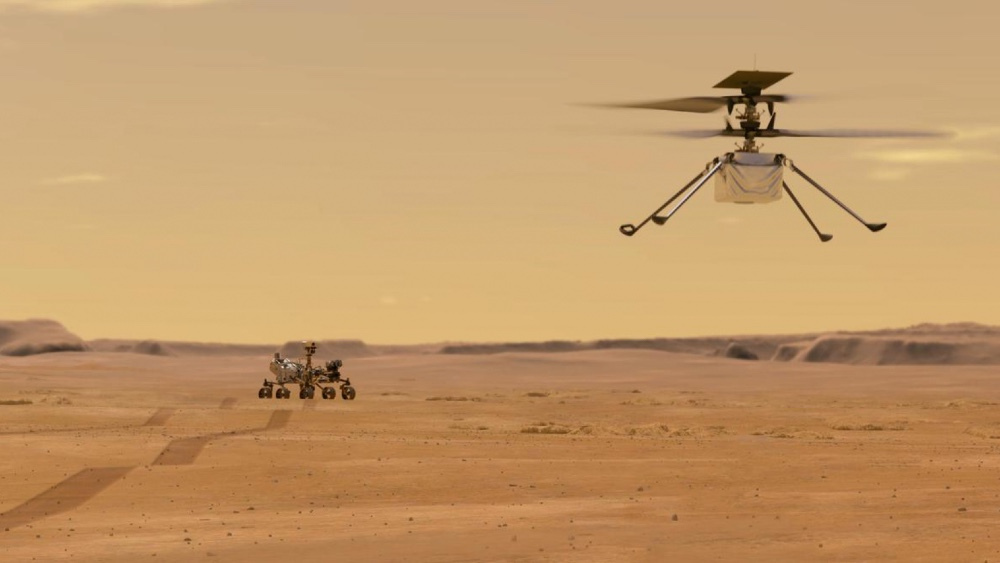Camera glitch almost causes Mars drone crash
NASA's Mars Ingenuity drone suffers navigation failure due to onboard camera malfunction

UPDATE: NASA’s Mars Ingenuity drone survived a navigation malfunction that could have ended in disaster. The incident was caused by a glitch in the drone’s camera image delivery pipeline during its sixth flight, which hindered its onboard navigation system.
Ingenuity’s downward-facing navigation cameras usually take 30 pictures a second of the surface and feed that stream into the navigation computer. Each time an image arrives the navigation system’s algorithm examines the timestamp and makes a prediction about what the camera should have seen at that moment (based on surface features recognized from previous images). The algorithm then looks at where those features actually appear in the image. The algorithm uses the difference between the predicted and actual locations of these features to correct its estimates of position, velocity, and attitude.
It’s this pipeline of images that suffered a glitch that put the entire system in jeopardy. A minute into the flight, the image pipeline suffered an error that caused it to drop a single photo from that 30 photos per second pipeline, resulting in all subsequent photos coming in with an improper timestamp.
The resulting inconsistencies significantly degraded the information used to fly the drone, but despite this error Ingenuity was able to touch down safely on the surface within 4.88m (16ft) of its intended landing location. Fortunately Ingenuity has a ‘stability margin’ that was designed to allow it to tolerate significant errors without crashing.
ORIGINAL STORY (25 Feb 2021): The landing of the Perseverance rover on Mars has already been incredibly exciting, with the recently released photos and audio of the rover giving all of us earthlings an interesting glimpse into what the Red Planet's surface is actually like. However, it seems that the best is yet to come, with the camera drone Ingenuity (more accurately described as a new type of helicopter) due to eventually take flight.
Ingenuity is officially known as an eVTOL (Electric Vertical Take-Off and Landing) aircraft. On the 300 million mile journey from Earth to Mars, Ingenuity was housed on the underbelly of Perseverance.
• Read more: Best camera drone
Get the Digital Camera World Newsletter
The best camera deals, reviews, product advice, and unmissable photography news, direct to your inbox!
As reported by Robb Report, the Ingenuity camera drone is powered by six lithium-ion batteries. Interestingly, these only account for 15% of the drone's total weight and can be recharged from the solar array on top of the airframe. Ingenuity will carry two cameras, one in color with a horizon-facing view and one in black-and-white that will be used for navigation.
Only 19.2 inches tall, Ingenuity has four carbon-fiber blades arranged into two counter-rotating rotors, which spin at roughly 2,400 RPM. Designed to counteract Mars' super-thin atmosphere, this RPM is actually around five times faster than the average helicopter.
While the Ingenuity camera drone will be able to communicate with NASA through the Perseverance rover, Ingenuity's flights won't actually be manually controlled by a human. This is because it takes almost 12 minutes for a signal to go from one planet to the other. Instead, Ingenuity has been preprogrammed with test scripts that will be performed when the camera drone receives activation signals.
NASA is apparently planning to begin flight tests with Ingenuity at some point in April – at which point we might begin to see even more exciting photos of the surface of Mars. In the meantime, we're sure the Perseverance rover has still got some exciting images and footage in store for us.
Read more
Best mirrorless camera
Best camera for astrophotography
Best lenses for astrophotography
Best CCD cameras for astrophotography
Best light pollution filters
With over a decade of photographic experience, Louise arms Digital Camera World with a wealth of knowledge on photographic technique and know-how – something at which she is so adept that she's delivered workshops for the likes of ITV and Sue Ryder. Louise also brings years of experience as both a web and print journalist, having served as features editor for Practical Photography magazine and contributing photography tutorials and camera analysis to titles including Digital Camera Magazine and Digital Photographer. Louise currently shoots with the Fujifilm X-T200 and the Nikon D800, capturing self-portraits and still life images, and is DCW's ecommerce editor, meaning that she knows good camera, lens and laptop deals when she sees them.

